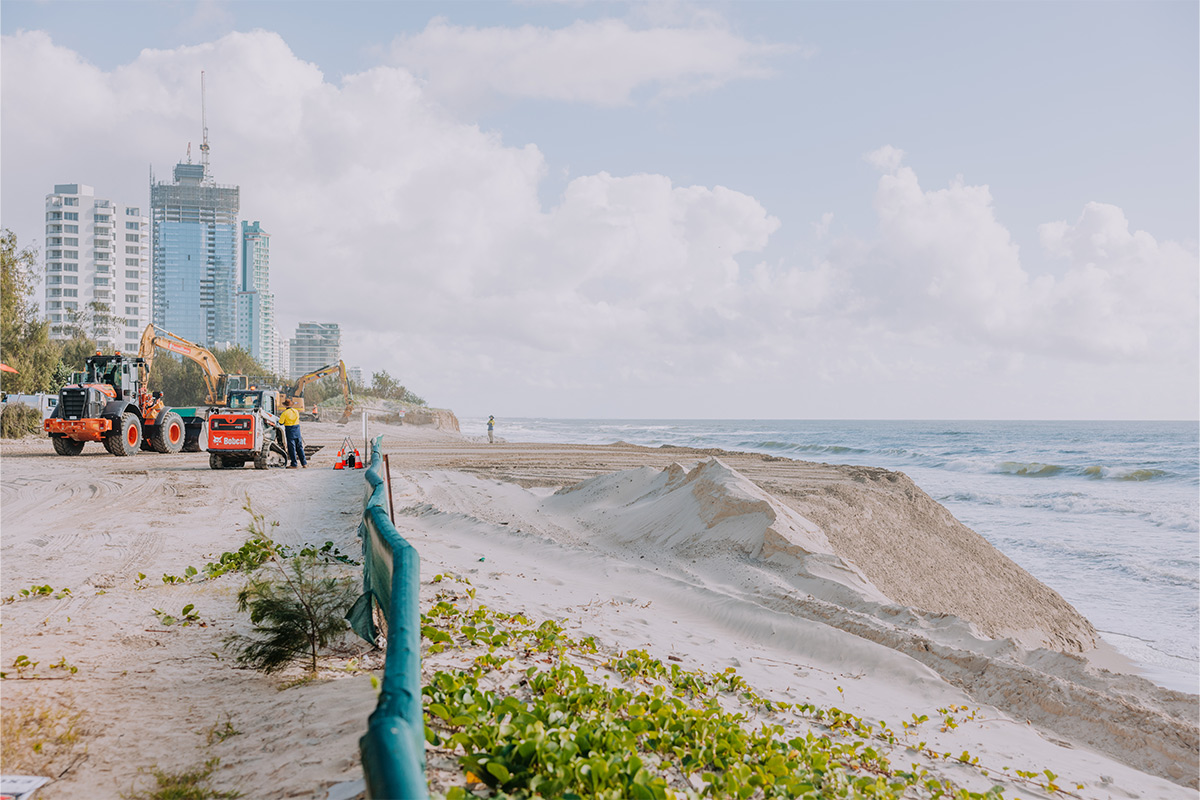What the Heck Is Regenerative Tourism, Anyway?

Skift Take

Listen Now
Subscribe
Apple Podcasts | Spotify | Overcast | Pocket Casts | Google Podcasts | Amazon | RSS
Kopit: Welcome back to the Skift Travel Podcast. I'm Skift's Editor-in-Chief Sarah Kopit, joined as always by Seth Borko, Skift's head of research.
So it goes without saying that the topic of sustainability has been a pressing issue across practically every facet of humanity for quite a while now. And travel, with its size and impact, has figured prominently into this conversation. And while as an industry, we're still largely grappling with what exactly travel looks like when it's truly sustainable, a new, related but distinct concept has started to emerge.
And that's the idea of regenerative tourism. And to help us talk through and better understand this emerging concept, we are happy to be joined today by Skift Research Analyst Robin Gilbert-Jones. Hey, Robin, how are you doing?
Gilbert-Jones: I'm great. Glad to be here.
Kopit: So Robin's the lead author of a Skift Research report titled Regenerative Tourism Fact from Fiction. And he's also spent many years focused on corporate responsibility and sustainability. So, Robin, let's just jump right in. I'm kind of a novice on this. I've heard the term, but can't tell you much about it. What the heck is regenerative tourism and how is it different from sustainable tourism?
Defining Regenerative Tourism
Gilbert Jones: Well, you're certainly not alone there. It's not always the most well-understood or well-defined concept, and it's pretty new. But the basic idea is to leverage tourism to leave destinations, communities and the environment better off than they would have been without tourism. So in short, you're trying to maximize positive impacts as opposed to just minimizing harmful impacts.
And it's kind of become attached to that whole post-Covid build back better concept. So taking a leap forward from sustainable tourism or certainly advocates of regenerative tourism can see it as taking a leap forward from sustainable tourism. So it certainly sees itself as something new and revolutionary and distinct from what we would traditionally call sustainable tourism.
There are some other distinct aspects of it as well. So it tends to emphasize — not just newness and innovation — but rediscovery of traditional wisdom. So if you look at destinations in, for example, Australasia and Latin America, it incorporates aspects of indigenous traditions and spirituality. And it also generally has a very strong community focus and emphasizes culturally immersive experiences and volunteerism for travelers.
So it kind of makes them more participants as opposed to just tourists.
Borko: So it's kind of like a little more holistic — like sustainable tourism is very science based, and maybe this is a more holistic approach.
Gilbert-Jones: Yeah, you could definitely say that. Depending on whom you speak to, it's purportedly science based as well. But yeah, it encompasses a broader range. And it's different in scope.
Borko: So I guess, it sounds great, right? It's almost like sustainability — plus it's got all these great things. There's still a science report and all this other stuff. And yet, I think that this is kind of maybe a controversial term. I think it gets if not pushback, it gets a lot of people rolling their eyes sometimes if we're be honest in some rooms.
Kopit: Accusations of being a little bit too woo woo maybe.
Borko: Yes. That's right. The technical term of being too woo woo. There is a bit of controversy around this idea. So maybe Robin, talk about why is there some controversy, some pushback around this idea that sounds great on paper.
How It's Different From Sustainable Tourism
Gilbert-Jones: Yeah. There's definitely a bit of woo woo fatigue. But that's not the only thing. There are some issues to consider. So first thing, as I mentioned, it tends to describe itself as being distinct from sustainable tourism or even more sophisticated or a more advanced form of it in that, it seeks to maximize positive impacts of tourism rather than just mitigating the negative harm.
But this can be a little bit unfair to sustainable tourism. And we actually interviewed a number of sustainable tourism experts, and this came up more than once. The objection was that — hang on a minute — sustainable tourism had always intended to improve destinations and maximize positive impact rather than just mitigate damage. So by saying that, you're kind of implying that sustainable tourism is kind of a fatalistic thing where you're just trying to minimize harm and tourism is inherently harmful.
So in order to claim that it represents something distinct and new regenerative tourism, it has a tendency to kind of make a straw man out of sustainable tourism, throw it under the bus a little bit. And people don't like that.
Borko: Would you say that there's like a bit of a turf war almost? People who built their career in sustainability are like, "Wait a second! We're the green people." Is that kind of what's going on?
Gilbert-Jones: Yeah. Who are these interlopers? There is a little bit of that. And I think a lot of these guys have been really in the trenches with sustainable tourism for years. So I can understand a bit of resistance on their part to this new kid on the block coming along claiming that it's superior.
And I mean, that speaks to another objection, which is that the idea that regenerative tourism is this new concept. It's certainly a newish term. But if you actually look at the practice of it ... so oftentimes, it's about repurposing previously unproductive or environmentally degraded sites for tourism and rejuvenating.
This has been going on for decades. One of the better-known examples is the Eden Project in the UK, which is built on a former clay pit. And there are many similar examples. One of the biggest tourist draws here in Cape Town, where I live, is the Victoria and Alfred Waterfront, which repurposed the original Docklands.
It's a huge mixed-use neighborhood with a heavy tourism focus. It gets over 23 million visitors a year. So it's kind of like, "Hey, you're claiming this is new." But is it really? But probably the most concerning criticism is there's no agreed upon methodology for measuring regenerative tourism or quantifying its impact. It tends to be super site specific, which isn't necessarily a bad thing because it's recognizing what the issues are at site level.
But it's really hard to come up with something generalizable, some kind of methodology for benchmarking it. And some destinations and businesses that market themselves as regenerative have come up with their own impact metrics and methodologies. But it's really variable. So it's hard to find good data to back up the claims of regenerative tourism and the like.
The Risk of Greenwashing
Kopit: Is this like greenwashing 2.0?
Gilbert-Jones: It risks being so. There's a risk. Well, there are two risks there. The data issue — on the one hand, it opens it up to being hijacked by greenwashing. But it also means there's a risk that it could become a distraction from the actual hard work of addressing climate change and reducing emissions.
And Seth, I like what you said the other day that addressing climate change is essentially an unsexy accounting problem — whereas something like regenerative tourism, the optics of it, and it could be a little distracting.
Kopit: I'm curious if you could tell us, Robin, about some other like some other examples? Like for our audience here who may still be trying to wrap their head around what exactly this is. Do you have any other kind of tangible things that maybe listeners might be like, "Oh yeah, OK, I get it now."
Gilbert-Jones: There's some interesting stuff being done. And I don't want to disregard the term. It's a broad church. It's very variable. And as I said, it's quite site specific. But one example is New Zealand has been really hot on regenerative tourism.
I mentioned that concept of making tourists participants and they have this concept of temporary localhood. So visitors to New Zealand are asked to sign the Tiaki Promise. And it's basically a pledge to almost becoming a temporary New Zealander and promising to care for the land.
And so at the sub-destination level, you've got something like Bay of Plenty. It's become very well recognized for this. They've done some really innovative work. And they've adopted something called the seventh-generation principle. So this originates from indigenous communities in North America. And it encourages visitors to consider the impact of their choices on people in the environment far in the future — so seven generations from now.
So it's encouraging that shift in mindset. So this kind of a behavior change aspect to it. Another one, sticking in the region ....
Borko: On this Bay of Plenty example, do you know how in terms of like science based? Actually, this is, I think, one of the conversations that's interesting is that there are these amazing callbacks and incorporations of these indigenous traditions and trying to make people more of a local and more respectful of the place. But do we know if Bay of Plenty is ... do they measure carbon?
Like I know the fact based off of the carbon emissions, CO2, greenhouse gases from that angle — that's the more traditional sustainable angle. How important is that to something? Do you know if that's important to Bay of Plenty?
Gilbert-Jones: It's still important. And if you read their sustainability reports, the short answer is that they're not checking out the importance of emissions measurement and things in favor of regenerative. So the two coexist. And I'm listing the more kind of specifically regenerative aspects of it — particularly the sort of indigenous and community aspects of it.
But yeah, it does coexist with a focus on climate and the environment.
Borko: And at the risk of being a little too controversial whatever. Like are there are there some projects that you think of that are calling themselves regenerative that maybe don't have as much of a science-based foundation?
Gilbert-Jones: Yeah. I mean, like I said, it's super variable. And sometimes, it's more of a kind of of identity than the method. In fact, you can't really call it a methodology because it sort of markets itself as a movement. So really, if a destination calls itself regenerative, it doesn't mean that they're not using science-based targets and that they don't have a rigorous approach. But it kind of doesn't say much about whether they do or they don't.
Kopit: I've learned in my 48 years to be suspicious of anything that calls themselves a movement.
Gilbert-Jones: Yeah.
Kopit: The woo woo fatigue. Yeah, I love that. I think we should like trademark that or something.
What Do Consumers Think
Borko: One of the things I know you've done a lot of research in is the consumer side of this, Robin. And so we're coining this term. We're going with it. What does woo woo fatigue with sustainable tourism regeneration ... What does it mean from a consumer side? How does it impact what consumers think about travel?
Gilbert-Jones: Well, our data does point to the fact that consumers are hungry for more sustainable options. And they believe it's important for businesses to act sustainably. You can ask consumers about regenerative. But, at the consumer level, it's not very well understood. So we have to kind of refer to sustainability.
But you're seeing a generational shift as well. So we've also found that Gen Z and millennial travelers are particularly engaged on sustainability and ecological issues. And they're very motivated in their travel decisions by a desire to connect with nature. So both regenerative and sustainable travel do fit nicely in there. And they also show concern about tourism's potential negative impact on local communities and cultural heritage.
And that's a big focus for regenerative. So again, it does test quite well there. But also consumers have also shown a willingness or at least profess a willingness to take personal action towards sustainable choices — even if it inconveniences them or cost them more. But crucially, it's important to note this doesn't always translate into action.
So there's what we call the say-do gap, where travel preferences don't necessarily match their behavior. And there are quite a few potential reasons for this. But an important one to consider is that they don't necessarily trust the sustainability claims being made by the tourism industry, which goes back to the earlier point about greenwashing and the need to actually demonstrate your impact.
And one of the other data points we found is that quite a lot of consumers are suspicious of some sustainability claims being made by tourism businesses and kind of think it's mostly just greenwashing.
Kopit: There's also just the general laziness of humans I find.
Borko: Never underestimate that factor.
Kopit: Never underestimate.
How the Travel Industry Can Engage Visitors
Borko: We were talking about challenges with the say-do gap in tourism and how many consumers either don't trust the industry or perhaps are a little bit lazy we might even say.
It reminds me of a story I heard. I was at dinner the other week, and I overheard some Gen Zs far cooler than me obviously at dinner next to me. And they were talking about their travel plans and they're talking about sustainability. This is a 100% true story — not made up for the podcast. And the conclusion they had was this is too complicated. I can't make a difference. I expect the businesses to just do it.
For me, that was their conclusion that I — obviously very rude to my partner, I put down my fork — I was eavesdropping really hard. So let's talk about that, Robin. What is the onus for sustainability on the travel industry and regenerative on the travel industry? And what does the industry need to do better either for regenerative or sustainability? What do you think about that, Robin?
Gilbert-Jones: The first thing to say is greenwashing is a huge issue for the industry. So, you need to be able to back up any sustainability claims you're making. Especially, when you look at the travel industry, it has a bit of a history with greenwashing. And I mean, the sustainability space in general — not just in travel. But travel has had a checkered history with it.
And whether the say-do gap relates primarily to distrust or laziness or a combination of both, the fact that businesses have not always been upfront about this, it certainly can't help. So claims have to be defensible. Third-party certification can help with that.
But it's also about engaging your visitors. And when you asked about who the onus is on ... of course, the owners. If you're a polluting industry like an airline or something like that, you've got to do something. But to give regenerative some credit here, it's also about how you engage with your visitors.
And I'd say that something regenerative tourism tends to get right is engaging with travelers in such a way that they feel included in the overall sustainability mission as participants rather than just like spectators on the sidelines. So going to that story that you told, maybe consumers and travelers in that sense feel disempowered because they don't have a role to play in sustainability.
And like I said, New Zealand has that Tiaki Pledge, which can potentially give travelers a sense of agency over their sustainable travel choices.
Building Trust Among Travelers
Borko: One of the things that I know that we talk about a lot is that greenwashing undermines consumer trust and deepens the say-do gap and ... and it seems like, "Oh, how can a solution be one size fits all? There's so many different destinations." But the importance of having some sort of standards is that it builds consumer trust and building consumer trust in green initiatives helps close the say-do gap.
To me, that was a really important insight in terms of how it's not just, "Oh, you know, all these matrixes and frameworks and methodologies are for the nerds." And they are — don't get me wrong, they are. But at the end of the day, they help. They're important for a reason.
Because if you don't measure what you're doing, it's not scalable. It's not sustainable. And it doesn't build that trust. I think that's a key point of this research.
Gilbert-Jones: Absolutely. I don't think anyone is expecting the average traveler to pour through reports by the Global Sustainable Tourism Council, EarthCheck or any of these kind of certification bodies. It's not really for public consumption, but if they can see that destinations and businesses are doing something. And it's about holding yourself to account.
So if you voluntarily signed up for an EarthCheck certification or some kind of third-party verification of what you're actually doing, and then it's actually having the effect that you're claiming it's having, just the act of doing that increases your credibility. And that's something that I think certainly if regenerative tourism is going to kind of take off in the way it wants to, it's going to need more of that.
Kopit: I want to give a shout out to my old boss in my old shop that, I don't know, I've kind of always wanted to do this because I thought it was such a cool example. Seth, have you ever been invited to the Bloomberg picnic in the summer?
Borko: No, I've not. I haven't had the pleasure.
Kopit: Yeah, it's this amazing event on Randall's Island in New York. They have it all over the world. But the one in New York, it was always kind of amazing to me because what they did. There were a couple garbage cans on the island, but not very many. Every single thing they brought onto that island for this massive party for thousands of people was compostable. Every single item.
And so, if you had to throw away something that you brought with you, you maybe had to walk like up a hill and to the gate to find a trash can. But everything else was compostable. And the reason that I love that so much is that I don't think that we should ... I like to put the onus on the businesses like we were saying. I think it's too hard for a consumer.
Like if I only go to the store and I see all plastic containers. I don't know ....
Borko: You're going to buy plastic. What choice do you have?
Kopit: What do I do? And so, you have this plastic and every time I take my recycling out, I look at this massive bag of plastic. And I'm like, "You know, Sarah, you could do better. Like you could." But then I think to myself, "How? How can I do better?" I don't know how to do it.
And if I did know how to do it, I would do it. And like the Bloomberg example is my favorite because you just had no choice. And I wish that companies, travel companies like the places that we all go — I wish they kind of didn't give us the option.
I don't know how that pertains to regenerative tourism, but it's been the story that I wanted to share for quite some time.
Borko: Let me tie it in for you if you'll let me ... it ties back to this like Bay of Plenty case study that Robin was talking about. I think that these moments where you don't give people a choice, when you take the horse to water, so to speak, it wants to drink in this particular case.
And it can be really impactful. So the stuff that we were talking about with Bay of Plenty and the indigenous wisdom and all that stuff ... on the one hand, you might say, you might have a skeptic, "That's woo woo! Where's the CO2 emissions? I want the numbers. I want the facts."
But also, I think I would bet that there are many visitors who come and they want to know about that history. They want to know that culture. They want to feel like locals. And that becomes that meaningful story that they want to tell. They don't really know why. They just want to tell that story on a podcast, right?
Yeah. That's the kind of thing that these destinations want. So I think it's if I can maybe thread some ... I think it speaks to how these it almost loops in with experiential travel how sustainability done well is and can become an experience and a story and immersive in a really meaningful way to consumers.
But usually not in a cheap way. Usually not in a cheap way. Bloomberg has enough money to.
Kopit: Exactly.
Borko: And that comes back to the credibility. Do I trust that if you're going to take me on this great experience, and I'm going to pay for it, that it's going to be worth it? I think that's the big piece of it.
Kopit: So Robin, what is the verdict? Let's get down to brass tacks. Should we embrace regenerative tourism as the path forward? We're all in the travel biz. Is this the holy grail? Or is it just a buzzword that kind of sells consultant contracts and is generally just a distraction from traditional sustainability?
What do you think?
Gilbert-Jones: Well, it's early days, and it's still being defined. It's still being ... it's still taking shape. So picking up on what you were saying there about the role of the travel consumer. I think this is where regenerative tourism can and sometimes does potentially get some stuff right.
And travelers don't like being constantly told how harmful their travel is. And so if you can leverage travel, to have a positive impact, that's empowering for travelers. And also, if you can bring them into the fold of the sustainability journey, as it were, that's also empowering.
And as Seth mentioned, that can be part of the experience. So that all kind of fits under the auspices of regenerative tourism and in cases where it's being done. Well, it's a good thing. But like I said, we just got to tread a little bit carefully. The sustainability space has a bit of a tricky history with trendy buzzwords.
No wonder people kind of roll their eyes, right? Because it can get very easily hijacked as a greenwashing tool. And once again, the best way to avoid that is actually tackling the data issue, I think as well. It's important to make the point that regenerative and sustainable tourism can coexist. They overlap a lot.
I think they overlap more than a lot of the regenerative tourism enthusiasts would like to admit. They kind of have to think of something completely different. But the most important thing — to go back to my point up top — as long as it's being done credibly with integrity and in a science-based way.
And most importantly, that it doesn't become this shiny new distraction from the actual nitty-gritty work of tackling climate change. Then go for it. But yeah, we just gotta tread carefully.
Skift’s in-depth reporting on climate issues is made possible through the financial support of Intrepid Travel. This backing allows Skift to bring you high-quality journalism on one of the most important topics facing our planet today. Intrepid is not involved in any decisions made by Skift’s editorial team.





